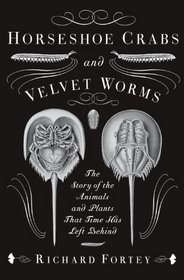Helpful Score: 1
"Thus with a swipe of flesh on stone we carry our vertebrate pedigree back 525 million years ... A silvery sliver of a thing took us away from trilobites and snails onto our own special path: one which led to land, to Tyrannosaurus Rex, and The New York Times.â
I struggled a bit with this -- I finally got through it one chapter at a time, giving myself a break not so much to contemplate as recover. I had to use a post-it note to mark my place if I stopped mid-way down a page, for even a moment, because I found myself reading the same paragraph over and over. And I can't claim that I honestly remember more than a 10th of it. To my eternal shame, I only discovered the beauty of science when my brain is too ossified (or fossilized?) to take it all in. But I'm trying!
And then, every so often, Fortey writes a line like the one quoted above, which is like poetry, and which I will remember, always, as an example of the beauty and importance of Fortey's quest to identify and, if possible, personally see, the oldest "survivors" from each genus of earth's creation -- "living fossils" like horseshoe crabs, lungwort and coelacanths. (Fortey does an excellent job of explaining why the term "living fossil" is completely inaccurate.) His quest takes him to all of the continents except Antarctica, although it's amusing that one Survivor, an unassuming little fish, takes him to the bottom of the garden of a house he lived in as a child. So, a quest into his own Deep Time, as well as that of the Earth.
There is a poignant quality to some of Fortey's encounters, as plants and creatures that have survived for millions of years, and in some cases multiple extinction events, are clinging to existence as humankind clears their habitats, poisons their ecosystems and unleashes non-native predators and competitors on them. We should be ashamed of ourselves. And the big question is, of course, have we set a countdown clock going on our own status as survivors of our particular evolutionary tree?
I struggled a bit with this -- I finally got through it one chapter at a time, giving myself a break not so much to contemplate as recover. I had to use a post-it note to mark my place if I stopped mid-way down a page, for even a moment, because I found myself reading the same paragraph over and over. And I can't claim that I honestly remember more than a 10th of it. To my eternal shame, I only discovered the beauty of science when my brain is too ossified (or fossilized?) to take it all in. But I'm trying!
And then, every so often, Fortey writes a line like the one quoted above, which is like poetry, and which I will remember, always, as an example of the beauty and importance of Fortey's quest to identify and, if possible, personally see, the oldest "survivors" from each genus of earth's creation -- "living fossils" like horseshoe crabs, lungwort and coelacanths. (Fortey does an excellent job of explaining why the term "living fossil" is completely inaccurate.) His quest takes him to all of the continents except Antarctica, although it's amusing that one Survivor, an unassuming little fish, takes him to the bottom of the garden of a house he lived in as a child. So, a quest into his own Deep Time, as well as that of the Earth.
There is a poignant quality to some of Fortey's encounters, as plants and creatures that have survived for millions of years, and in some cases multiple extinction events, are clinging to existence as humankind clears their habitats, poisons their ecosystems and unleashes non-native predators and competitors on them. We should be ashamed of ourselves. And the big question is, of course, have we set a countdown clock going on our own status as survivors of our particular evolutionary tree?




